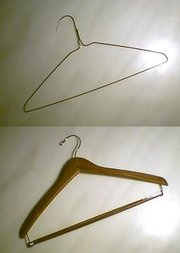Clothes hanger

A clothes hanger, or coat hanger, is a device in the shape of human shoulders designed to facilitate the hanging of a coat, jacket, sweater, shirt, blouse or dress in a manner that prevents wrinkles, with a lower bar for the hanging of pants.
There are two basic types of clothes hangers, the wire hanger, a simple loop of wire in a flattened triangle shape, with the wire continuing into a hook at the top, and the wooden hanger, a flat piece of wood cut into a boomerang-like shape, and with the edges sanded down to prevent damage to the clothing, with a hook, usually of metal, protruding from the point. Some wooden hangers have a rounded bar from tip to tip, forming a flattened triangle, this bar is designed to hang the pants belonging to the jacket. There are also plastic coat hangers, which mostly mimic the shape of either a wire or wooden hanger. Plastic coat hangers are also produced in smaller sizes to accommodate the shapes of children's clothes.
There are also clothes hangers that have been padded with fine materials, such as satin, for expensive clothes, lingerie and fancy dresses. The soft, plush padding is intended to protect garments and keep them from getting shoulder dents from wire hangers.
President Thomas Jefferson invented the wooden clothes hanger. However, today's most used hanger, the wire hanger, was inspired by a coat hook that was invented in 1869 by O. A. North of New Britain, Connecticut.
In 1903, Albert J. Parkhouse, an employee of the Timberlake Wire and Novelty Company in Jackson, Michigan, tired of hearing the complaints of coworkers about too few coat hooks in the factory, bent a piece of wire into two ovals and twisted the ends together to form a hook, and thus invented the first basic wire hanger. In 1932, Schuyler C. Hulett patented an improved design, which used cardboard tubes mounted on the upper and lower parts of the wire to prevent wrinkles, and in 1935, Elmer D. Rogers added a tube on the lower bar, which is still used.
Wire clothes hangers are infamous as the symbol of illegal, and self-inflicted, abortion, for which uncoiled and straightened out wire hangers have been used as a tool. They are also commonly used to forcibly gain entry into automobiles; however with the increased complication of car locks and entry systems, such methods are often unsuccessful on newer cars.
A wire clothes hanger was also a featured prop in a central scene in the 1981 movie Mommie Dearest, in which Joan Crawford, played by Faye Dunaway, went into the room of her daughter, Christina, at night while the girl was sleeping to admire the clothes hanging nicely in her closet. She then became enraged upon discovery that Christina had once again used a cheap wire hanger, instead a nice one as she had instructed her to use, woke her up and gave her a thrashing.
(This article contains text taken from Hanger History with permission).
